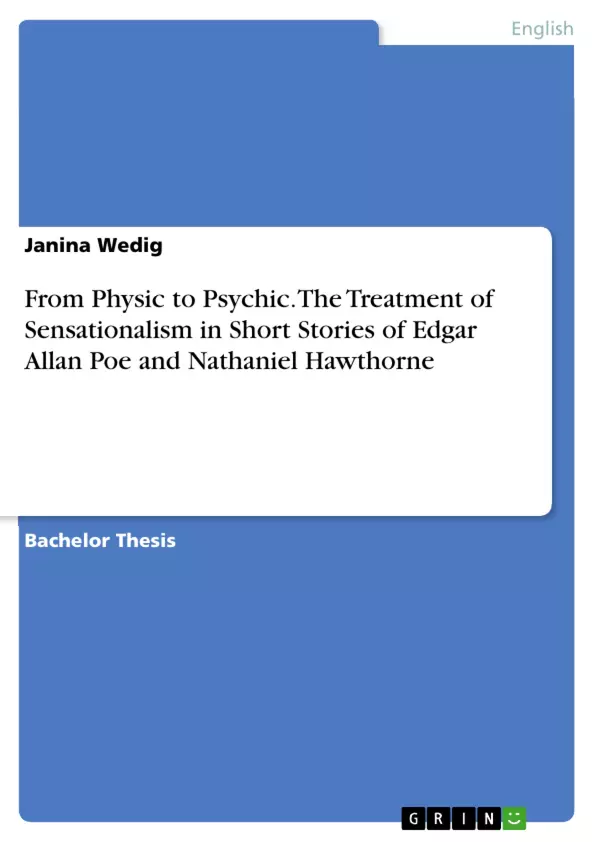
From Physic to Psychic. The Treatment of Sensationalism in Short Stories of Edgar Allan Poe and Nathaniel Hawthorne
Bachelorarbeit, 2013
36 Seiten, Note: 2.0
Leseprobe
Inhaltsverzeichnis (Table of Contents)
- Introduction
- Sensationalism in Britain and Antebellum America
- A Brief History of Sensationalism
- Definition and Key Features
- Journalism
- Fiction
- Criticism and Defence
- Elitist Sensationalism a la Blackwood's
- Blackwood's Edinburgh Magazine
- The Blackwood's Sensation Tale
- Edgar Allan Poe's Sensationalism
- Poe and Parody
- Blackwood's Parodies in Psyche Zenobia's tales
- Exploitation of the Genre in “The Premature Burial”
- Hawthorne's Allegoric Sensationalism
- Hawthorne and Sensationalism
- Treatment and Transformation of Sensational Themes
- Psychological Sensationalism in \"Wakefield\"
- Sensational Material in \"Egotism; or, The Bosom Serpent\"
Zielsetzung und Themenschwerpunkte (Objectives and Key Themes)
This paper aims to demonstrate the impact of Sensationalism on 19th-century literature by examining how Edgar Allan Poe and Nathaniel Hawthorne reacted to and responded to contemporary journalistic and literary Sensationalism. The paper will explore how these authors utilized the genre's themes and materials for their own purposes.
- The historical development of Sensationalism in Britain and America
- The definition and key features of Sensationalist writing
- The influence of Blackwood's Edinburgh Magazine on the development of a specific form of Sensationalist fiction
- Poe's parody of Blackwood's sensational tales and his use of Sensationalist elements in his own stories
- Hawthorne's transformation of Sensationalist themes into allegorical and psychological narratives
Zusammenfassung der Kapitel (Chapter Summaries)
The first chapter provides a brief history of Sensationalism, tracing its origins back to the 16th century and examining its evolution in the 17th, 18th, and 19th centuries. It explores the changing nature of Sensationalist writing, highlighting its transition from religious moralizing to an emphasis on individual psychology and the exploration of crime and its motives. The chapter also examines the growing popularity of Sensationalism in the 19th century, with the rise of mass media and the proliferation of newspapers.
The second chapter delves into the specific characteristics of Blackwood's Edinburgh Magazine, a prominent Scottish periodical of the 19th century. It discusses the magazine's role in promoting a particular type of Sensationalist fiction, characterized by its elitist nature and focus on psychological horror. The chapter explores the magazine's influential writers and their contributions to the development of a distinct Blackwood's style.
Chapter four focuses on Poe's relationship with Blackwood's Magazine and his attempts to parody the magazine's brand of Sensationalism. It examines Poe's short stories, "How to Write a Blackwood Article" and "A Predicament," which are considered satires of Blackwood's sensationalist fiction. The chapter also explores how Poe exploited sensationalist elements in his own stories, notably in "The Premature Burial," by exaggerating and ridiculing the extreme physical experiences often depicted in Blackwood's tales.
Chapter five shifts its attention to Hawthorne and his engagement with Sensationalism. The chapter examines Hawthorne's stories "Wakefield" and "Egotism; or, The Bosom Serpent," showcasing how he employed sensational material while transforming those themes into more allegorical and psychological narratives. It argues that Hawthorne's brand of Sensationalism, unlike Poe's, focuses less on physical violence and more on the exploration of internal psychological states and moral complexities.
Schlüsselwörter (Keywords)
This paper focuses on the themes of Sensationalism, 19th-century literature, Gothic fiction, Blackwood's Edinburgh Magazine, Edgar Allan Poe, Nathaniel Hawthorne, parody, psychological horror, and the relationship between journalism and fiction.
Details
- Titel
- From Physic to Psychic. The Treatment of Sensationalism in Short Stories of Edgar Allan Poe and Nathaniel Hawthorne
- Hochschule
- Ruhr-Universität Bochum
- Veranstaltung
- Sensationalism in Short Stories of Edgar Allan Poe and Nathaniel Hawthorne
- Note
- 2.0
- Autor
- Janina Wedig (Autor:in)
- Erscheinungsjahr
- 2013
- Seiten
- 36
- Katalognummer
- V266364
- ISBN (eBook)
- 9783656560555
- ISBN (Buch)
- 9783656560579
- Dateigröße
- 522 KB
- Sprache
- Englisch
- Schlagworte
- from physic psychic treatment sensationalism short stories edgar allan nathaniel hawthorne
- Produktsicherheit
- GRIN Publishing GmbH
- Preis (Ebook)
- US$ 16,99
- Preis (Book)
- US$ 18,99
- Arbeit zitieren
- Janina Wedig (Autor:in), 2013, From Physic to Psychic. The Treatment of Sensationalism in Short Stories of Edgar Allan Poe and Nathaniel Hawthorne, München, Page::Imprint:: GRINVerlagOHG, https://www.diplomarbeiten24.de/document/266364
- Autor werden
- Ihre Optionen
- Vertriebskanäle
- Premium Services
- Autorenprofil
- Textarten und Formate
- Services für Verlage, Hochschulen, Unternehmen

- © GRIN Publishing GmbH.
- Alle Inhalte urheberrechtlich geschützt. Kopieren und verbreiten untersagt.
- info@grin.com
- AGB
- Open Publishing
Der GRIN Verlag hat sich seit 1998 auf die Veröffentlichung akademischer eBooks und Bücher spezialisiert. Der GRIN Verlag steht damit als erstes Unternehmen für User Generated Quality Content. Die Verlagsseiten GRIN.com, Hausarbeiten.de und Diplomarbeiten24 bieten für Hochschullehrer, Absolventen und Studenten die ideale Plattform, wissenschaftliche Texte wie Hausarbeiten, Referate, Bachelorarbeiten, Masterarbeiten, Diplomarbeiten, Dissertationen und wissenschaftliche Aufsätze einem breiten Publikum zu präsentieren.
Kostenfreie Veröffentlichung: Hausarbeit, Bachelorarbeit, Diplomarbeit, Dissertation, Masterarbeit, Interpretation oder Referat jetzt veröffentlichen!
- GRIN Verlag GmbH
-
- Nymphenburger Str. 86
- 80636
- Munich, Deutschland
- +49 89-550559-0
- +49 89-550559-10
- info@grin.com
-









